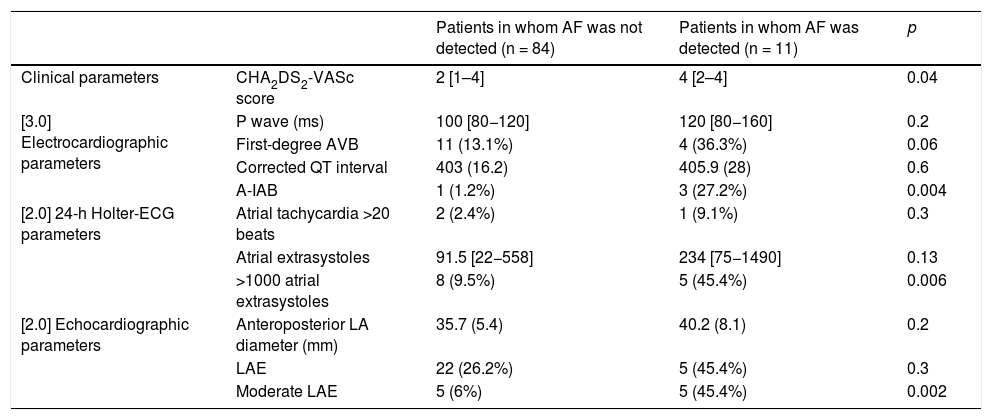Atrial fibrillation (AF) detection in patients with embolic stroke of underdetermined source (ESUS), entails a change of medical treatment and a significant decrease in the incidence of new strokes. It is necessary to determine which patients would benefit more from prolonged electrocardiographic monitoring. Our aim was to find electrocardiographic and echocardiographic AF predictors in patients with ESUS.
MethodsWe performed a cohort study that included 95 consecutive patients admitted to the hospital because of an ESUS. An electrocardiogram, each subject in the study underwent a 24-h Holter-electrocardiogram (Holter-ECG) and an echocardiogram. A 2-year follow up was also conducted, with a 24-h Holter-ECG every three months for the first year, and every 6 months during the second one.
ResultsDuring the follow-up, AF was detected in 11 patients (11.6%), with a detection rate of 3.2% at 6 months, 7.4% at 12 months, and 11.6% at 18 months as well as at 24 months. The variables that were independently related to AF detection included moderate or severe left atrium dilation (p = .02), interatrial advanced block (p = .04) and more than 1000 premature atrial beats on 24 h Holter-ECG (p = .01).
ConclusionsModerate or severe atrial dilation, interatrial advanced block, and the presence of more than 1000 premature atrial beats on 24 h Holter-ECG behave as AF predictors in patients with ESUS.
En el accidente cerebrovascular embólico de origen indeterminado (ESUS), la detección de fibrilación auricular (FA) conlleva un cambio de tratamiento y una reducción drástica en la incidencia de nuevos ictus. Es necesario determinar qué pacientes se benefician en mayor medida de una monitorización electrocardiográfica prolongada. Nuestro objetivo fue la búsqueda de predictores electrocardiográficos y ecocardiográficos de FA en pacientes con ESUS.
Materiales y métodosSe diseñó un estudio observacional de cohortes en el que se incluyeron 95 pacientes consecutivos que ingresaron por ESUS en un hospital terciario. A todos se les realizó un electrocardiograma (ECG), un Holter electrocardiograma (Holter-ECG) de 24 horas y un ecocardiograma durante el ingreso. Se realizó un seguimiento presencial durante dos años mediante Holter-ECG de 24 horas, trimestral durante el primer año y semestral durante el segundo.
ResultadosDurante el seguimiento, se detectó FA en 11 pacientes (11,6%), siendo la tasa detección del 3,2% a los 6 meses, 7,4% a los 12 meses, y 11,6% a los 18 y a los 24 meses. Las variables que se relacionaron de forma independiente con el desarrollo de FA fueron la dilatación en grado moderado o severo de la aurícula izquierda (AI) (p = 002), el bloqueo interauricular avanzado (BIA-A) (p = 0,04), y la presencia de más de 1000 extrasístoles auriculares (EA) en Holter-ECG de 24 horas (p = 0,01).
ConclusionesLa dilatación en un grado moderado o severo de AI, el BIA-A, y la presencia de más de 1000 EA en Holter-ECG de 24 horas se comportan como predictores independientes de FA en pacientes con ESUS.











